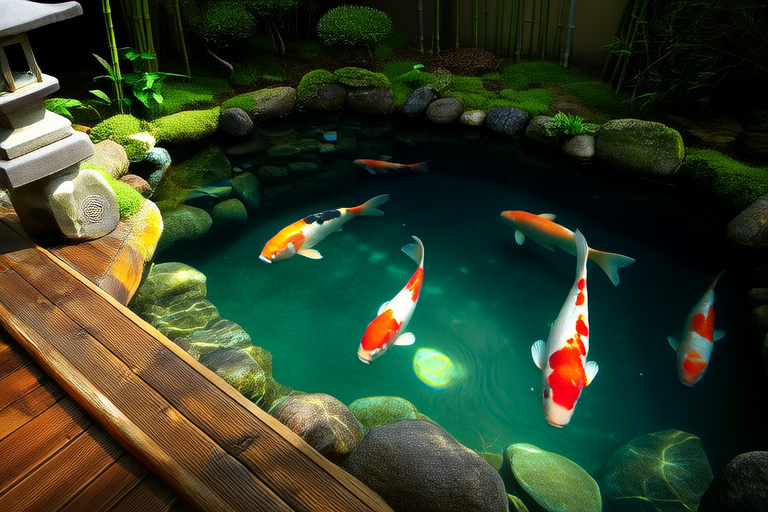Koi Pond Care: Top Secrets for Vibrant and Healthy Fish
Keeping koi fish in a pond can be a rewarding hobby, but it requires dedication and knowledge to ensure that your aquatic friends remain vibrant and healthy. From water quality maintenance to proper feeding techniques, there are many aspects to consider. This article will guide you through the top secrets for keeping your koi pond thriving, providing insights from both novice and experienced koi keepers.
Water Quality Maintenance
The foundation of any successful koi pond lies in maintaining excellent water quality. Clean water ensures that your fish have the best possible living conditions, promoting their health and longevity.
- Regular Filtration: A good filtration system is crucial for removing debris, excess food, and harmful bacteria from the water. It also helps maintain appropriate oxygen levels. For instance, Rob, a seasoned koi keeper, swears by his dual filtration setup, which keeps his pond crystal clear year-round.
- Aeration: Koi require well-oxygenated water to thrive. Adding an aerator or waterfall feature not only improves oxygenation but also adds visual appeal to your pond.
- Water Testing: Regular testing of pH, ammonia, nitrite, and nitrate levels is essential. This allows you to catch potential issues early before they affect your fish. Experts recommend testing weekly during warmer months when biological processes accelerate.
Proper Feeding Techniques
Feeding your koi correctly is another critical aspect of pond care. Overfeeding can lead to poor water quality, while underfeeding may result in malnutrition.
- Quality Food: Choose high-quality koi pellets that provide balanced nutrition. Look for products rich in protein, vitamins, and minerals. Avoid cheap feeds that might contain fillers detrimental to your fish’s health.
- Feeding Frequency: Feed your koi two to three times daily, especially during spring and summer when they’re most active. Reduce feedings as temperatures drop in autumn and winter. For example, Mark, who lives in a colder climate, cuts back significantly once the temperature consistently falls below 50°F (10°C).
- Portion Control: Only give what your fish can consume within five minutes. Excess food decomposes quickly, polluting the water and stressing the fish.
Disease Prevention Strategies
Preventing diseases is easier than treating them. By implementing these strategies, you can significantly reduce the risk of infections affecting your koi.
- Quarantine New Arrivals: Always quarantine new koi for at least two weeks before introducing them into your main pond. This helps identify any underlying health issues early on.
- Stress Management: Minimize stressors such as overcrowding, sudden changes in water parameters, or aggressive behavior among fish. Stress weakens immune systems, making fish more susceptible to illnesses.
- Biological Controls: Introduce beneficial bacteria and natural predators like certain types of snails to help control algae growth and maintain ecological balance.
Suitable Pond Environment Setup
The physical environment of your koi pond plays a significant role in supporting fish health and happiness.
- Pond Size: Ensure adequate space for each fish, typically allowing around 20 gallons per inch of adult koi. Larger ponds provide better stability against fluctuations in water quality.
- Shelter: Provide hiding spots using rocks, plants, or artificial structures. These shelters offer protection from predators and harsh weather conditions.
- Depth: Aim for a minimum depth of four feet to prevent freezing during winter and excessive heating during summer. Deeper areas also allow for stratification, creating different temperature zones within the pond.
Seasonal Care Adjustments
Your koi pond management needs vary throughout the year due to changing environmental factors.
- Spring: Perform a thorough cleaning of filters and pumps after winter hibernation. Gradually increase feeding amounts as temperatures rise.
- Summer: Monitor water temperature closely; koi prefer cooler waters between 68°F and 77°F (20°C – 25°C). Increase aeration if necessary.
- Fall: Prepare for colder weather by reducing feeding frequency and amount. Check for signs of parasites or fungal infections common this time of year.
- Winter: If your pond freezes over, ensure there’s an opening for gas exchange. Some enthusiasts install de-icers specifically designed for ponds.
Beneficial Plants Selection
Introducing suitable plants enhances the aesthetics of your koi pond while offering numerous benefits to its inhabitants.
- Oxygenators: Submerged plants like Anacharis produce oxygen through photosynthesis, improving overall water quality.
- Surface Coverage: Floating plants such as Water Hyacinths shade parts of the pond, reducing algae growth caused by excessive sunlight exposure.
- Natural Filters: Emergent plants like Cattails absorb nutrients from the water, acting as natural filters. They also provide shelter for small fry and other aquatic life.
In conclusion, caring for koi involves understanding their needs and adapting practices accordingly. By focusing on water quality, appropriate feeding, disease prevention, ideal environments, seasonal adjustments, and beneficial plant selections, you set yourself up for success in maintaining a vibrant and healthy koi pond. Remember, every pond is unique, so continuously observe and adjust your approach based on your specific circumstances. Happy koi keeping!
